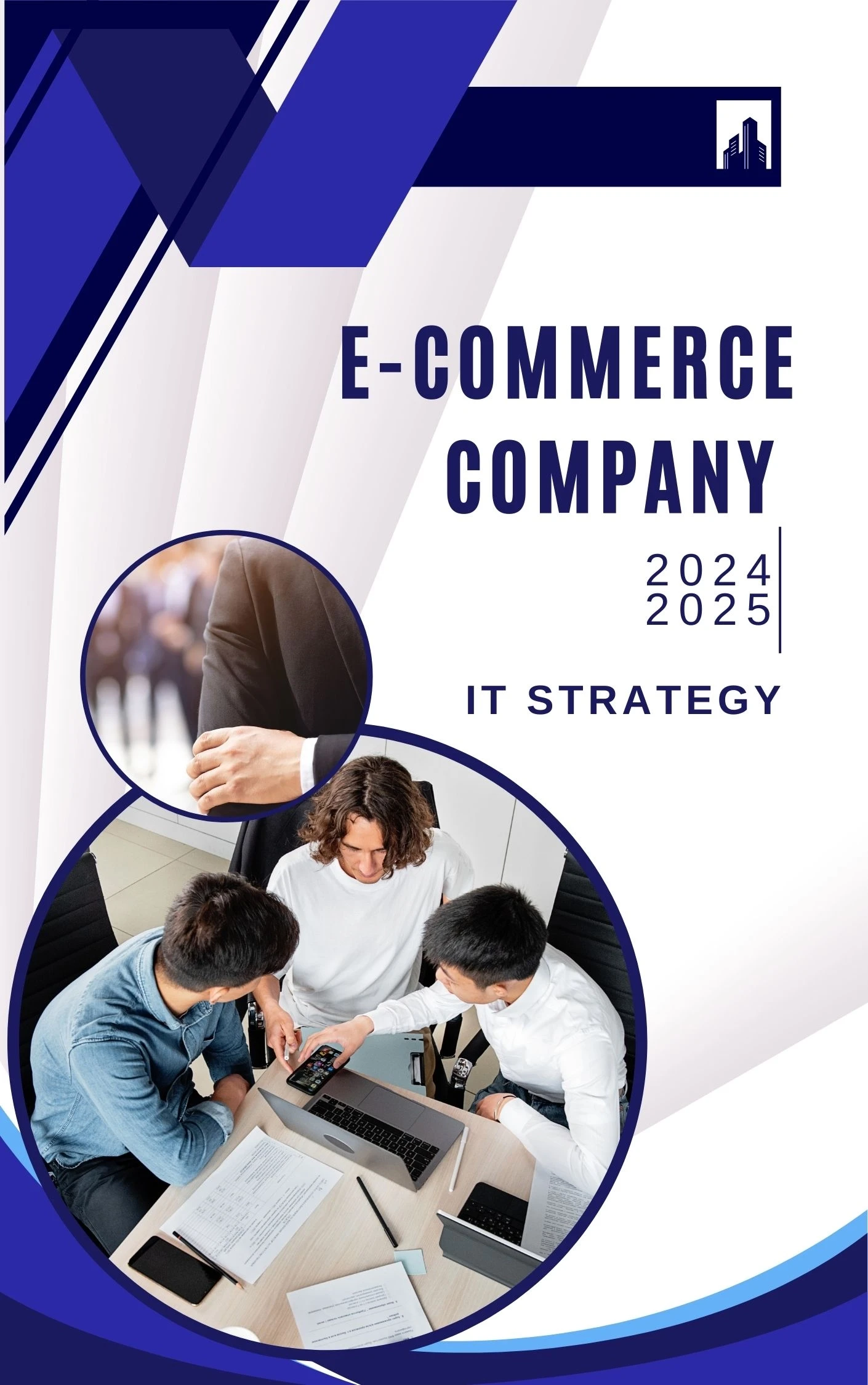Business Objective: Increase market share and improve customer experience.
Understand Business Objectives
- Goal: Expand market presence by 20% within the next two years.
- Objective: Enhance website performance, implement advanced analytics, and personalize customer interactions.
Assess the Current IT Environment
- Infrastructure Audit: Review website hosting, server capacity, and application performance.
- Capability Analysis: Evaluate the IT team’s skills in web development, cybersecurity, and data analytics.
- SWOT Analysis: Strengths (robust customer database), Weaknesses (slow website load times), Opportunities (emerging markets), Threats (cybersecurity threats).
Identify Key IT Initiatives
- Website Optimization: Implement a content delivery network (CDN) and optimize website code to improve load times.
- Advanced Analytics: Deploy analytics tools like Google Analytics and Tableau for better customer insights.
- Personalization: Use machine learning algorithms to recommend products based on customer behaviour.
Develop an Implementation Roadmap
- Short-Term Goals: Improve website load times within six months.
- Long-Term Projects: Develop and integrate a recommendation engine within 18 months.
- Milestones and Timelines: Monthly progress reviews and quarterly performance assessments.
Budgeting and Resource Allocation
- Financial Planning: Allocate $xyz for website optimization and analytics tools.
- Resource Allocation: Hire additional data scientists and web developer.
Governance and Risk Management
- IT Governance Framework: Establish a project management office (PMO) to oversee IT initiatives.
- Risk Management: Develop a cybersecurity plan and conduct regular penetration testing.
Performance Measurement
- KPIs and Metrics: Website load time (goal: under 2 seconds), increase in conversion rate (goal: 10% improvement).
- Continuous Improvement: Quarterly reviews to refine personalization algorithms.
Communication and Training
- Stakeholder Communication: Monthly newsletters and quarterly meetings with key stakeholders.
- Training Programs: Conduct training sessions on new analytics tools and cybersecurity best practices.
Technology Selection and Procurement
- Vendor Evaluation: Evaluate CDN providers (e.g., Cloud flare, Akamai) and analytics tools.
- Procurement Processes: Follow a structured RFP process for vendor selection.
Execution and Monitoring
- Project Management: Use Agile methodologies to manage the implementation of the recommendation engine.
- Monitoring and Reporting: Weekly sprints and monthly progress reports
- New
Business Objective: Improve patient care and operational efficiency.
Understand Business Objectives
- Goal: Enhance patient outcomes and reduce operational costs by 15%.
- Objective: Implement electronic health records (EHR) and telemedicine solutions.
Assess the Current IT Environment
- Infrastructure Audit: Review current patient management systems and IT infrastructure.
- Capability Analysis: Assess the IT team’s proficiency in healthcare IT systems.
- SWOT Analysis: Strengths (experienced medical staff), Weaknesses (outdated patient management system), Opportunities (telemedicine), Threats (regulatory compliance).
Identify Key IT Initiatives
- EHR Implementation: Select and deploy a comprehensive EHR system.
- Telemedicine: Implement a secure telemedicine platform for remote consultations.
- Data Integration: Integrate patient data across various systems for better care coordination.
Develop an Implementation Roadmap
- Short-Term Goals: Implement EHR system in two pilot departments within six months.
- Long-Term Projects: Roll out telemedicine services across all departments within two years.
- Milestones and Timelines: Bi-monthly reviews and yearly performance evaluations.
Budgeting and Resource Allocation
- Financial Planning: Budget $2 million for EHR and telemedicine implementation.
- Resource Allocation: Hire additional IT support staff and provide training for healthcare professionals.
Governance and Risk Management
- IT Governance Framework: Create an IT governance committee to oversee healthcare IT projects.
- Risk Management: Ensure compliance with HIPAA and other healthcare regulations.
Performance Measurement
- KPIs and Metrics: Patient satisfaction scores, reduction in operational costs, and increase in telemedicine consultations.
- Continuous Improvement: Regular feedback from medical staff and patients to improve EHR and telemedicine systems.
Communication and Training
- Stakeholder Communication: Regular updates to medical staff and administrative personnel.
- Training Programs: Comprehensive training on EHR usage and telemedicine protocols.
Technology Selection and Procurement
- Vendor Evaluation: Evaluate EHR and telemedicine providers (e.g., Epic, Cerner, Teladoc).
- Procurement Processes: Use a formal procurement process with detailed RFPs and vendor demos.
Execution and Monitoring
- Project Management: Utilize project management best practices to ensure timely delivery of IT initiatives.
- Monitoring and Reporting: Continuous monitoring of system performance and user feedback.
- New
Business Objective: Enhance data security and regulatory compliance.
Understand Business Objectives
- Goal: Strengthen data security measures to protect client information.
- Objective: Achieve full compliance with GDPR and other relevant regulations.
Assess the Current IT Environment
- Infrastructure Audit: Review current data storage, access controls, and security measures.
- Capability Analysis: Evaluate the IT team’s expertise in cybersecurity and regulatory compliance.
- SWOT Analysis: Strengths (robust IT infrastructure), Weaknesses (outdated security protocols), Opportunities (regulatory compliance as a competitive advantage), Threats (cyber attacks).
Identify Key IT Initiatives
- Security Enhancements: Implement advanced security solutions like multi-factor authentication (MFA) and encryption.
- Compliance Tools: Deploy tools for data privacy and compliance management.
- Employee Training: Conduct regular cybersecurity awareness training for all employees.
Develop an Implementation Roadmap
- Short-Term Goals: Implement MFA within three months.
- Long-Term Projects: Achieve full GDPR compliance within 12 months.
- Milestones and Timelines: Quarterly security audits and compliance checks.
Budgeting and Resource Allocation
- Financial Planning: Allocate $1 million for security enhancements and compliance tools.
- Resource Allocation: Hire a dedicated compliance officer and additional cybersecurity experts.
Governance and Risk Management
- IT Governance Framework: Establish a cybersecurity governance framework with clear roles and responsibilities.
- Risk Management: Regularly update risk assessments and response plans.
Performance Measurement
- KPIs and Metrics: Number of security incidents, compliance audit results, employee training completion rates.
- Continuous Improvement: Ongoing review of security policies and procedures.
Communication and Training
- Stakeholder Communication: Regular updates to executive management and board members.
- Training Programs: Mandatory cybersecurity training and phishing simulation exercises.
Technology Selection and Procurement
- Vendor Evaluation: Assess cybersecurity vendors and compliance management tools.
- Procurement Processes: Follow a structured procurement process with detailed evaluations and pilot testing.
Execution and Monitoring
- Project Management: Use project management frameworks to ensure timely implementation of security measures.
- Monitoring and Reporting: Continuous monitoring of security systems and regular reporting to stakeholders.
- New





